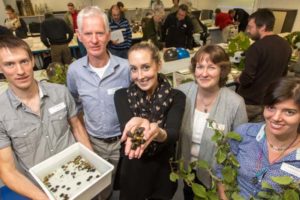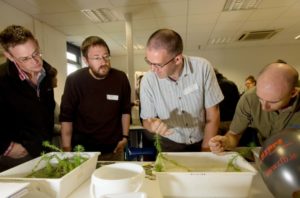Early warnings and rapid response urged at IT Sligo Workshop
With more than 10 aquatic invasive species detected in Irish waters in the last decade, the importance of their early identification and management was discussed at a workshop in IT Sligo last week, organised by IT Sligo, Inland Fisheries Ireland and the National Biodiversity Data Centre, and supported by the Environmental Sciences Association of Ireland.
Introduced species – which can range from jellyfish to aquatic plants – enter Irish waters through a variety of pathways and their presence can pose a significant threat to biodiversity.
The most recent discovery was a freshwater jellyfish detected in Loughs Derg and Erne last month which has been identified as originating from the Yangtze River Valley in China.
Other species include Lagarosiphon Major, a pondweed which continues to be intensively managed in Lough Corrib to prevent its interference with trout angling, and also the Asian Clam, which is present in high numbers in the Shannon and the Barrow navigations.
Ecologist and lecturer Dr Frances Lucy is an international expert in aquatic invasive species. Together with colleagues in IT Sligo, she has formed a new research centre at the Institute called the Centre for Environmental Research Innovation and Sustainability (CERIS), which is focused on developing and increasing research capacity in the areas of applied ecology and resource management.
She said that the increase in international travel and trade is a factor in the increase of these invasive species in our freshwater; “Invasive species enter out waterways a number of ways,” she said, “but there is no doubt that the increase in international travel is a huge factor. We do not want the unwelcome presence of invasive species. Something as simple as emptying a fish tank into a river or down the sin can also result in the introduction of plant and animal invaders.”
The workshop at IT Sligo – attended by representatives from Inland Fisheries Ireland, the Loughs Agency, the EPA, National Parks and Wildlife Service, Sligo and Galway County Councils, the OPW, Waterways Ireland and the Royal Society for the Protection of Birds and Queens University Belfast – was held to raise awareness of the threats posed by the invasive species and to educate people working in Ireland’s freshwater about their responsibilities in their early identification and management. The stakeholders in attendance also contributed ideas and suggestions.
Dr Lucy continued; “These species are recognised to be the second greatest threat to our biodiversity. In addition, not only can they cause problems for our water supplies, they can also adversely affect recreational activities like fishing and boating. As Ireland strives to achieve its target under the EU Water Framework Directive ahead of the 2015 deadline, it’s critical that all agencies who work in our waterways proactively co-operate with Inland Fisheries Ireland in their work to manage them.”
Dr. Joe Caffrey, Inland Fisheries Ireland, said that anyone who finds anything unusual they suspect to be an invasive species should contact IFI directly. To contact the IFI see www.fisheriesireland.ie
Caption for photo (above): Pictured at the Freshwater Invasive Species Workshop at IT Sligo with some examples of invasive species inhabiting Irish freshwaters were; Wayne Trodd, Environmental Protection Agency; Gary Free, Environmental Protection Agency; Paul McLoone, Inland Fisheries Ireland; Oisin Naughton, Inland Fisheries Ireland
Caption for photo (top): Pictured at the Freshwater Invasive Species Workshop at IT Sligo with some examples of invasive species inhabiting Irish freshwaters were IT Sligo research student Rory Sheehan, Joe Caffrey, Inland Fisheries Ireland, Sara Meehan, IT Sligo research student, Dr Frances Lucy, IT Sligo lecturer and ecologist and Colette O’Flynn, National Biodiversity Data Centre.

